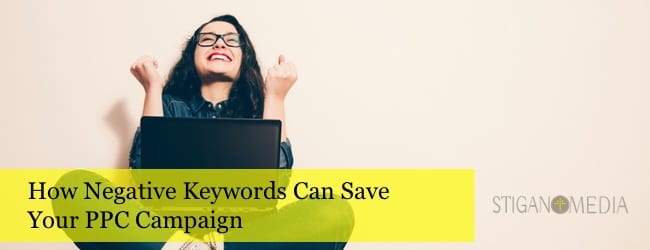The world of digital marketing moves pretty fast, which can sometimes cause companies to overspend on their PPC (Point Per Click) advertising. While it is important to stay up to date with your Search Engine Marketing keywords that can generate traffic and sales on your company’s website, it is just as important to manage and stay up to date with the negative keywords associated with the advertisements for your product or brand.
Negative keywords can quickly become a costly problem if they are allowed to remain associated with a certain ad, as they can initially cause a consumer to click on the ad, only to discover your actual website features a different product or service, unrelated to the original search. To improve your click to sale conversion rate, and save your company a significant amount of money, it is important to stay on top of these negative keywords.
So what exactly are these negative keywords? Google AdWords defines them as “a kind of keyword that prevents your ads from showing on irrelevant search queries.” An example of a negative keyword would be something like this: Imagine you are a plumber in Vancouver and have started to advertise online. For your PPC campaign you would likely want to list a word like “jobs” as a negative keyword. That way, you will avoid having your site appear in searches like “plumbing jobs”, which is good for you, since you aren’t hiring, and don’t want to spend any of your PPC budget on other plumbers looking for work.
There are a number of tools that marketers use to identify and isolate negative keywords like this one. Some are designed to actively identify negative keywords and are better suited to companies that often run different multiple PPC campaigns. Other tools take a more generalized approach to negative keywords, and are better suited to smaller companies like our plumber example that may not advertise as much or as often.
Here are few other tips to keep in mind when identifying negative keywords:
- Make searching for and identifying negative keywords a part of your company’s regular tasks, not just something you have completed for each new ad campaign. This will help you save a lot of money in the long run. In fact Negative Keywords should be added at least once a month if not weekly.
- Be as specific as possible when identifying negative keywords. There is a fine line between identifying the right words and identifying too many negative keywords. For example, it’s usually not a good idea to categorize a word like ‘green’ as a negative keyword. Since it is such a generally used word, it will be difficult to anticipate a time when won’t be relevant to a search related to your company.
- Do not identify your competitors as negative keywords. This may seem like an easy way to streamline your searches, but it can actually end up limiting the amount of exposure your company gets compared to your competitors.
With these tips you should be on your way to PPC Success, looking for a list of Negative Keywords? No Problem! Just fill out our form here and you will get access to our FREE List of Negative Keywords to use on your Search Engine Marketing Campaign.
To learn about more ways you can get the most out of your company’s digital marketing campaigns check out our Blog or feel free to contact us via email or phone. You can also check us out on Facebook and Twitter to see our latest updates.
Stigan Media is an award-winning web design & marketing agency specializing in WordPress, WebFlow, and Shopify. Our team focuses on SEO, PPC and conversion optimization strategies to help your company grow.







 Get in touch
Get in touch



